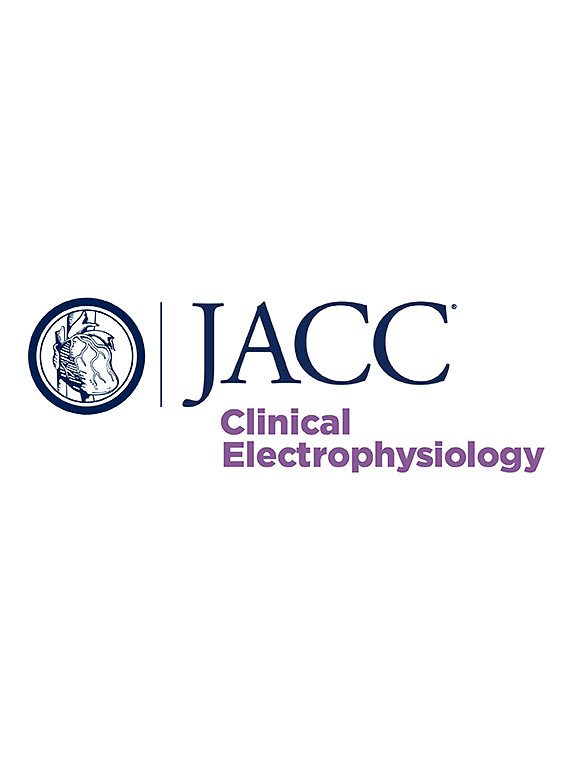脂肪瘤增生促进非缺血性心肌病患者的室性心动过速
IF 8
1区 医学
Q1 CARDIAC & CARDIOVASCULAR SYSTEMS
引用次数: 0
摘要
背景:非缺血性心肌病(NICM)患者的室性心动过速(VT)基质在分布和内部位置上非常复杂:本研究试图验证以下假设:心肌脂肪瘤化生(LM)是非缺血性心肌病和VT患者VT走廊的重要解剖基质,LM能稳定VT走廊中的电流传播:在 INFINITY(前瞻性心肌内脂肪沉积和心肌病室性心动过速)研究的 49 名 NICM 患者中,通过后期钆增强心脏磁共振图像计算出心肌瘢痕和/或 LM 内潜在的 VT 通道,并与电解剖图进行比对。通过夹带或起搏图估算出的穿过 VT 入口、峡部和/或出口部位的走廊被定义为 VT 走廊。使用计算机断层扫描分别区分 LM 和瘢痕。测量了每条走廊的电流振幅 SD:结果:与 151 个非 VT 走廊相比,35 个 VT 走廊穿越的 LM 量要高得多,中位数为 236.6 毫克(IQR:13.5-903.4 毫克),而非 5.8 毫克(IQR:0.0-57.9 毫克)(P < 0.001)。在可计算电流振幅的走廊中,28 个 VT 走廊沿走廊的电流变化较小,SD 为 8.0 μA(第 25-75 百分位数:6.1-10.3 μA),71 个非 VT 走廊为 14.9 μA(第 25-75 百分位数:8.5-23.7 μA)(P < 0.001):与旁观者走廊相比,NICM 中的 VT 电路走廊更有可能穿越 LM,并表现出较小的电流振幅变化。本文章由计算机程序翻译,如有差异,请以英文原文为准。
Lipomatous Metaplasia Facilitates Ventricular Tachycardia in Patients With Nonischemic Cardiomyopathy
Background
Ventricular tachycardia (VT) substrate in patients with nonischemic cardiomyopathy (NICM) is complex in distribution and intramural location.
Objectives
This study sought to test the hypothesis that myocardial lipomatous metaplasia (LM) is a vital anatomic substrate for VT corridors in patients with NICM and VT, and that LM stabilizes current propagation in VT corridors.
Methods
Among 49 patients with NICM in the 2-center INFINITY (Prospective Intra-Myocardial Fat Deposition and Ventricular Tachycardia in Cardiomyopathy) Study, potential VT viable corridors within the myocardial scar and/or LM were computed from late gadolinium enhancement cardiac magnetic resonance images and were registered with electroanatomical maps. Corridors passing through VT entrance, isthmus, and/or exit sites, estimated by entrainment or pace mapping, were defined as VT corridors. LM was separately distinguished from scar using computed tomography. The SD of current amplitude along each corridor was measured.
Results
Compared with 151 non-VT corridors, 35 VT corridors traversed a substantially higher volume of LM, with a median 236.6 mg (IQR: 13.5-903.4 mg) vs 5.8 mg (IQR: 0.0-57.9 mg) (P < 0.001). Among corridors with computable current amplitude, 28 VT corridors exhibited substantially lower current variation along the corridors, with SD 8.0 μA (25th-75th percentile: 6.1-10.3 μA) vs 14.9 μA (25th-75th percentile: 8.5-23.7 μA) among 71 non-VT corridors (P < 0.001). Individual VT circuit sites (95 out 118) were highly colocalized with LM.
Conclusions
VT circuitry corridors in NICM are more likely to traverse LM and exhibit reduced current amplitude variation compared with bystander corridors.
求助全文
通过发布文献求助,成功后即可免费获取论文全文。
去求助
来源期刊

JACC. Clinical electrophysiology
CARDIAC & CARDIOVASCULAR SYSTEMS-
CiteScore
10.30
自引率
5.70%
发文量
250
期刊介绍:
JACC: Clinical Electrophysiology is one of a family of specialist journals launched by the renowned Journal of the American College of Cardiology (JACC). It encompasses all aspects of the epidemiology, pathogenesis, diagnosis and treatment of cardiac arrhythmias. Submissions of original research and state-of-the-art reviews from cardiology, cardiovascular surgery, neurology, outcomes research, and related fields are encouraged. Experimental and preclinical work that directly relates to diagnostic or therapeutic interventions are also encouraged. In general, case reports will not be considered for publication.
 求助内容:
求助内容: 应助结果提醒方式:
应助结果提醒方式:


